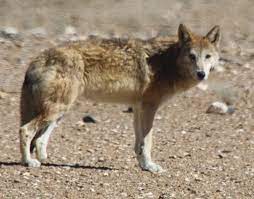ForumIAS announcing GS Foundation Program for UPSC CSE 2025-26 from 27th May. Click Here for more information.
Source-This post is based on the article “The first-ever IUCN assessment of the Himalayan Wolf is out. And it is grim” published in “DownToEarth” on 12th January 2024.
Why in the News?
The Himalayan Wolf (Canis lupus chanco) has been assessed for the first time on the International Union for Conservation of Nature (IUCN) Red List.
About Himalayan Wolf

| Specifications | Details |
| What is it? | It is a subspecies of the gray wolf found in the Himalayan region, spanning areas such as Nepal, India, and the Tibetan Plateau. |
| Conservation Status | IUCN: Vulnerable CITES: Appendix I Wildlife Protection Act, 1972: Schedule I |
| Distribution | 1. The Himalayan wolf resides on the Tibetan Plateau in China, particularly in Gansu, Qinghai, Tibet, and western Sichuan provinces. 2. In Northern India, the Himalayan wolf is found in Ladakh and the Lahaul-Spiti region in northeastern Himachal Pradesh. Note- India is also home to the Indian/Common/Peninsular Wolf (Canis lupus pallipes) found in the plains and the Deccan Plateau. |
| Population | The assessment estimates that there are 2,275-3,792 mature individuals scattered throughout the Himalayan region, encompassing Nepal, India, and the Tibetan Plateau. |
| Threats | 1. Illegal hunting for the illicit trade of its fur and body parts, including paws, tongues, heads, and other components. 2. Encroachment 3. Depletion of prey populations |
| Features | 1. Himalayan wolves are smaller and more compact than other subspecies, characterized by shorter legs and snouts. 2. Well-adapted to the harsh mountainous terrain, they possess strong limbs and a stout body, enabling them to navigate and survive in challenging environments. |
What measures are recommended in the assessment?
1. Ensuring the well-being of prey populations.
2. Enhancing livestock guarding techniques.
3. Addressing feral dog populations.
4. Implementing transboundary conservation initiatives.
5. Integrating the Himalayan Wolf into conservation programs for increased protection.
What is International Union for Conservation of Nature (IUCN)?
UPSC Syllabus- Environment




